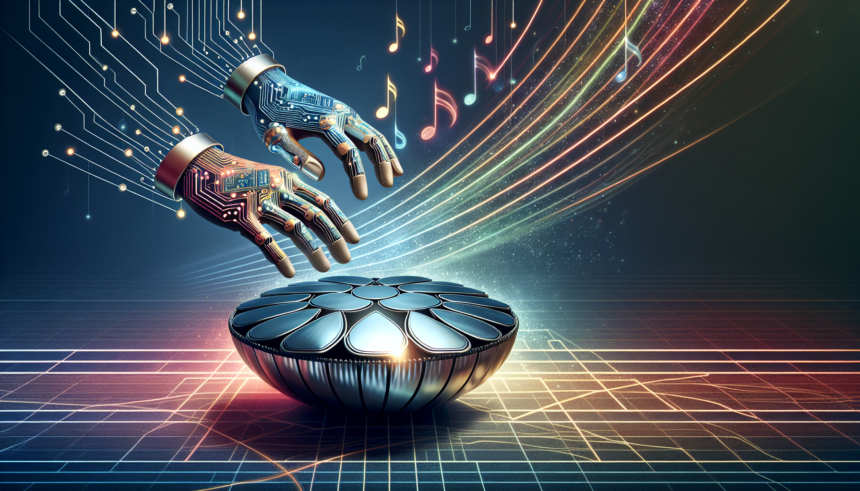<!DOCTYPE html>
<html lang="en">
<head>
<meta charset="UTF-8">
<meta name="viewport" content="width=device-width, initial-scale=1.0">
<title>Document</title>
</head>
<body>
<p>In recent years, the rapid development of technology has opened up new avenues for creating and experiencing music. One of the most fascinating innovations at the intersection of music and technology is the advent of handpan gloves. This unique instrument combines the tactile experience of playing a traditional handpan with the versatility of digital technology, offering musicians a new way to create and explore soundscapes. In this article, we'll dive into the world of seamless integration between music and technology with handpan gloves, examining their origins, functionality, and the broader implications for the music industry.</p>
<h2>The Evolution of Musical Instruments</h2>
<p>The history of musical instruments has been a journey of technological advancements, from primitive percussion instruments to intricate orchestral tools and, more recently, to digital synthesizers and electronic instruments. With each new development, musicians have gained new possibilities for expression. The handpan, a relatively modern invention originating in the early 2000s, has captivated musicians with its ethereal and resonant sounds that blend traditional percussion with melodic overtones.</p>
<p>Handpan gloves take this innovation a step further by integrating digital technology with the handpan's tactile playing experience. These gloves are equipped with sensors and haptic feedback mechanisms that allow musicians not only to play traditional notes but also to manipulate a wide variety of digital sounds, effects, and tonal variations. This marriage of physical and digital elements is the cornerstone of seamless integration in the modern musical landscape.</p>
<h2>How Handpan Gloves Work</h2>
<p>At the core of handpan gloves lies a sophisticated combination of sensors and software. These gloves are typically fitted with motion sensors, accelerometers, and pressure-sensitive components that detect the musician's hand movements and gestures. The data collected by these sensors is then transmitted to a connected device - typically a computer or a smartphone - that interprets the inputs and produces corresponding sounds or effects.</p>
<p>The seamless integration comes from the ability to customize and program the gloves to control a wide spectrum of audio parameters. Musicians can assign different sounds, effects, or even lighting cues to specific gestures or hand positions, providing them with a new palette of creative possibilities. This creates an interactive performance environment where the traditional boundaries between an instrumentalist and a digital performer blur, allowing for unique, dynamic expressions of music.</p>
<h2>Applications and Benefits</h2>
<p>Incorporating technology into traditional music-making is not just about novelty; it presents tangible benefits and possibilities for musicians and audiences alike. One significant advantage is the range of sounds and effects that can be achieved with handpan gloves. Musicians can morph between different styles and genres seamlessly, integrating world music influences with contemporary electronic sounds in real time during performances.</p>
<p>Moreover, handpan gloves can be particularly beneficial for educational purposes. They offer an intuitive and engaging way for beginners to learn about music, rhythm, and sound manipulation. The interactive nature of the gloves can captivate students and provide educators with a valuable tool for teaching musical principles.</p>
<p>Beyond education, handpan gloves also expand the possibilities for collaboration among musicians from different backgrounds. By integrating digital elements into the handplaying experience, artists who may not have traditionally collaborated due to differences in instrumentation or genre can find common ground, experimenting and creating new sonic landscapes together.</p>
<p>For audiences, the integration of handpan gloves into performances offers a visual and auditory spectacle. The ability to pair musical gestures with visual effects, such as lighting or projections, creates a comprehensive sensory experience that can enhance the emotional impact of live performances, making concerts more engaging and memorable.</p>
<h2>The Impact on the Music Industry</h2>
<p>As technology continues to evolve, the music industry must adapt to new trends and innovations. The integration of handpan gloves into the musical realm is a reflection of the broader trend towards digital integration and accessibility. Artists can no longer ignore the role of technology in shaping how music is created, distributed, performed, and consumed.</p>
<p>One significant impact is the democratization of music creation. Handpan gloves, like other technological advancements, lower the barriers for entry into music production. Musicians no longer need access to expensive studios or a wide array of physical instruments to create professional-sounding music. Instead, they can utilize affordable and accessible digital tools to bring their artistic visions to life.</p>
<p>Furthermore, the rise of handpan gloves and similar technologies emphasizes the importance of live performances in the digital age. As music streaming becomes the norm for consuming music, artists are seeking new ways to connect with audiences on a personal level. The immersive experience offered by handpan gloves in live settings provides a way for musicians to engage audiences, encouraging them to attend live performances and fostering a deeper connection between artist and listener.</p>
<h2>Challenges and Future Prospects</h2>
<p>While the integration of handpan gloves into music offers exciting possibilities, it also raises challenges that must be addressed. One key challenge is ensuring accessibility for artists from diverse backgrounds. As with any technological innovation, there is a risk of creating disparities between those who can afford and understand the technology and those who cannot. Addressing this requires continuous efforts to make handpan gloves financially and educationally accessible to aspiring musicians.</p>
<p>There are also concerns about maintaining the authenticity of traditional music while integrating digital elements. Musicians must navigate the delicate balance between preserving the cultural significance of traditional instruments and embracing new technologies. This dilemma requires a thoughtful approach to ensure that the innovations enhance rather than overshadow the traditional elements of music-making.</p>
<p>Looking ahead, the future of handpan gloves and similar technologies is promising. As the technology matures, we can expect further advancements in sensor accuracy, software sophistication, and the creation of even more immersive musical experiences. Moreover, collaborations between technologists, musicians, and educators hold the potential to expand the applications of handpan gloves beyond music, integrating them into fields such as therapy, gaming, and virtual reality.</p>
<h2>Conclusion</h2>
<p>The seamless integration of music and technology with handpan gloves is a testament to the evolving nature of artistic expression. By blending the tactile experience of traditional handpan playing with the versatility of digital technology, handpan gloves offer musicians a new realm of creative possibilities. As this innovation continues to gain traction, it has the potential to reshape the music industry, making music creation more accessible, engaging, and interactive.</p>
<p>Embracing the digital age while preserving the essence of traditional music is a challenge that musicians and technologists must address collaboratively. However, the future is bright as this intersection of music and technology continues to inspire and transform, offering exciting opportunities for musicians, educators, and audiences alike. As we move forward, handpan gloves serve as a reminder of the limitless possibilities that emerge when technology and art work in harmony.</p>
<h2>FAQs</h2>
<h3>1. What are handpan gloves?</h3>
<p>Handpan gloves are an innovative musical instrument combining the tactile experience of traditional handpan playing with digital technology. Equipped with sensors and haptic feedback mechanisms, these gloves allow musicians to manipulate a wide variety of digital sounds and effects.</p>
<h3>2. How do handpan gloves work?</h3>
<p>Handpan gloves use sensors such as accelerometers and pressure-sensitive components to detect hand movements and gestures. The data is transmitted to a connected device that interprets the inputs and produces corresponding sounds or effects, allowing for customized and interactive musical performances.</p>
<h3>3. What are the benefits of using handpan gloves?</h3>
<p>Handpan gloves offer a range of benefits, including expanding the sounds that can be achieved, providing engaging educational experiences, fostering collaboration among musicians, and enhancing live performances with immersive visual and auditory elements.</p>
<h3>4. How do handpan gloves impact the music industry?</h3>
<p>The integration of handpan gloves into the music industry democratizes music creation, lowering barriers for entry and emphasizing the importance of live performances. They encourage artists to explore new ways of connecting with audiences through immersive experiences.</p>
<h3>5. What challenges do handpan gloves present?</h3>
<p>Challenges include ensuring accessibility for diverse artists and maintaining the authenticity of traditional music while integrating digital elements. Addressing these challenges requires efforts to make handpan gloves financially and educationally accessible and to thoughtfully balance tradition with innovation.</p>
</body>
</html>Seamless Integration: The Intersection of Music and Technology with Handpan Gloves

Leave a comment




